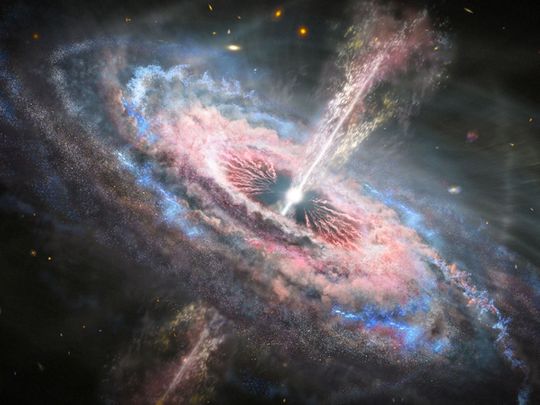
Millions of stars make up millions of galaxies in the universe, but which is the brightest of them all?
Click start to play today’s space-themed Word Search.
Astronomers call it WISE J224607.57-052635.0 – a galaxy that lingers at the edge of the visible universe. Its light shines brighter than 300 trillion sun-like stars, according to a May 2015 report in the National Geographic. But its brilliance doesn’t actually come from starlight – it’s from a giant “quasar” (one of the words you can spot in today’s word jumble).
From our planet, a quasar looks like any regular star, but it is actually a gigantic black hole that exists in the middle of a galaxy’s core. It draws in gas so fast that it heats up to millions of degrees and creates a beacon bright enough to be seen from across the universe! This particular quasar weighs 10 billion times the mass of our sun, according to researchers who published a report in the June 2015 edition of the US-based Astrophysical Journal.
Quasars aren’t just incredibly bright, they can be incredibly large, too.
In 2013, astronomers thought they discovered a structure in the universe that was so large, cosmological theory says it should not exist. The researchers, who published their study in the UK-based journal Monthly Notices of the Royal Astronomical Society, used data from the Sloan Digital Sky Survey, a US-based astronomical survey organisation that creates detailed 3D maps of the universe. They discovered a record-breaking cluster of quasars that stretched four billion light-years across.
In comparison, our own galaxy, the Milky Way, extends just 100,000 light-years across, while the supercluster of galaxies in which it is located – the Virgo cluster – spreads only 100 million light-years wide.
While astronomers knew that quasars could form massive clusters, the epic size of what is known as the Large Quasar Group (LQG), comprising 73 quasars, stumped researchers. Their current astrophysical models show that the upper size limit for cosmic structures should be no bigger than 1.2 billion light-years (the LQG is a whopping four times bigger).
The discovery just goes to show there’s so much we still don’t know about the incredible universe… and so much waiting to be revealed.
Play today’s Word Search and be inspired! Let us know if you enjoyed it at games@gulfnews.com.








